
- Aug 05, 2025
Global Trade of Inverters: Trends, Types, Trade Hubs & Forecast
They are used in everything from solar power systems and electric cars to home gadgets and industrial machinery. As per Inverters Import Data by Import Globals, the demand for intelligent and efficient inverters has increased as the world's energy consumption moves toward decentralized and renewable systems. These gadgets guarantee steady power delivery in areas with erratic or unstable electrical supplies in addition to promoting the integration of renewable energy.
The exponential growth of energy storage systems, smart grids, and solar installations is directly associated with the increase in worldwide inverter trade. While wealthy economies concentrate on modernizing their energy infrastructure with cutting-edge, AI-driven inverters, developing countries are implementing inverter technology to increase electricity access. As per Inverters Export Data by Import Globals, a strong global market with several production hubs, export-import networks, and strategic trade ramifications has been produced by this dynamic transition. Inverters are positioned to become a key component of the next-generation power environment as the emphasis on sustainability increases globally.
What Are Inverters?
The majority of home appliances and industrial machinery use alternating current (AC) power, which is produced by inverters, which are electrical devices that change direct current (DC) electricity, usually produced by solar panels, batteries, or other renewable sources, into AC electricity. As per Import Export Trade Data by Import Globals serves as a link between power generation and consumption, allowing renewable energy sources to provide usable electricity to the grid or to end consumers directly. Inverters are a vital part of both conventional and contemporary energy infrastructures since they are necessary for solar photovoltaic (PV) systems, backup power systems, electric cars, and other electronic gadgets.
Types of Inverters
1. String Inverters
One of the most popular inverter types for small-scale business and residential solar installations is the string inverter. As per Import Custom Data by Import Globals, this configuration consists of a "string" of solar panels connected to a single inverter. The string's whole DC output is transformed into usable AC power by these inverters. They are reasonably simple to install and maintain, and they are reasonably priced. One drawback is that if even one panel performs poorly because of dirt or shade, it might have an impact on the string's overall performance.
2. Central Inverters
Large, high-capacity devices called central inverters are frequently used in large commercial projects or utility-scale solar farms. For DC-to-AC conversion, they integrate the energy from several solar panel strings into a single unit. Central inverters require a lot of room, ventilation, and careful system design, but they are more cost-effective per watt and effective for high-volume energy conversion. If a panel in the chain performs poorly, it could experience system-wide performance decreases, just like string inverters.
3. Microinverters
Each solar panel has a tiny gadget called a microinverter linked to it. Microinverters enable independent operation of each panel, in contrast to string or central inverters. As per Import Trade Analysis by Import Globals, this maximizes energy collection by ensuring that the performance of one panel doesn't impact the others, particularly in installations with partial shade or varying orientations. Microinverters are more expensive per watt, but they provide more flexibility in system design, real-time monitoring, and increased efficiency.
4. Hybrid Inverters
Advanced devices known as hybrid inverters combine the capabilities of battery and solar inverters. They oversee the process of converting DC to AC and storing extra energy in batteries. These inverters provide resilience and energy independence during power outages, making them perfect for off-grid and backup systems. In areas where energy self-sufficiency is a top concern or where grid reliability is an issue, they are becoming more and more popular.
5. Battery Inverters
Energy storage devices are specifically made to function with battery inverters. When necessary, they control the transformation of batteries' stored DC energy into AC power. As per Export Data by Import Globals, systems that require variable energy usage and backup, or that add batteries to an existing solar setup, employ battery inverters. They are essential for emergency power supply, peak shaving, and load shifting.
Product Quality and Standards
Inverter performance and quality are essential for maintaining system safety, energy efficiency, and dependability. As per Import Data by Import Globals, good inverters usually go through a lot of testing and meet international certifications and standards like IS 16221 in India, UL 1741 for inverters used in North America, and IEC 62109 for safety. These standards evaluate things like grid compliance, electromagnetic compatibility, temperature tolerance, and electrical safety. Efficiency ratings, which typically fall between 95% and 99%, show how well an inverter converts DC to AC with the least amount of loss. To improve longevity and long-term performance, top manufacturers also include features like surge protection, anti-islanding protection, and sophisticated cooling systems. Purchasing certified, high-quality inverters guarantees interoperability with smart grid systems, boosts energy output, and lowers maintenance costs.
Product Analysis
Inverters have developed into sophisticated energy management tools that are more than just basic DC-to-AC converters. Innovations in energy storage, renewable energy, and grid modernization are driving their rising demand. Key product attributes and trends are broken down as follows:
Efficiency: By offering conversion efficiencies ranging from 95% to 99%, the majority of contemporary inverters minimize energy losses.
Smart Features: Real-time performance tracking, app monitoring, and Wi-Fi integration are now commonplace.
Scalability: Energy systems may be easily expanded thanks to modular inverter designs.
Cooling Mechanisms: To maintain the ideal temperature, high-quality inverters employ fan-based systems or sophisticated heat sinks.
Durability: Particularly in outdoor solar systems, products are made to endure harsh weather conditions.
Grid Support: Reactive power regulation, anti-islanding protection, and grid synchronization are now common features of many inverters.
Form Factors: Available in big industrial units for utility-scale projects and small sizes for domestic use.
Major Manufacturing Hubs and Firms
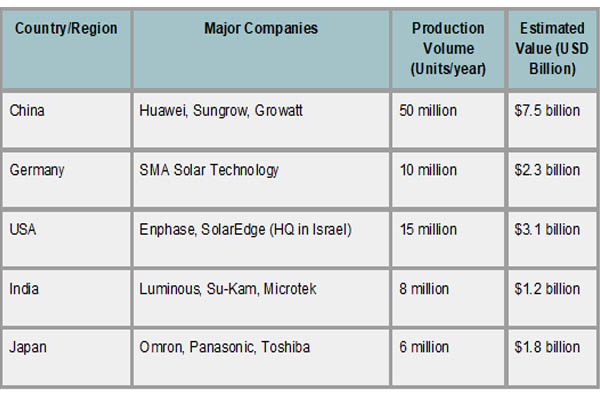
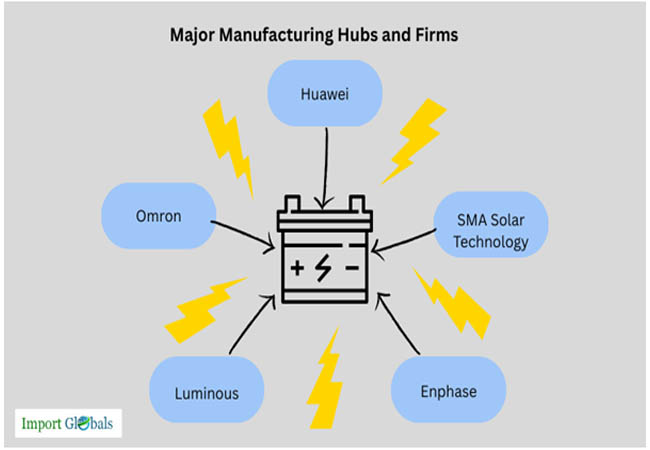
As per Import Trade Statistics by Import Globals, the global inverter manufacturing landscape is dominated by a mix of established tech giants and specialized clean energy companies, with key production hubs located in China, Germany, the United States, India, and Japan.
China leads the market both in terms of volume and innovation, with companies like Huawei, Growatt, and Sungrow producing millions of units annually. Germany is home to premium brands like SMA Solar Technology, known for high-efficiency and durable systems. The U.S. features top firms like Enphase Energy and SolarEdge (based in Israel but with major U.S. operations), pioneers in microinverter technology. India hosts large-scale production from brands like Luminous and Microtek, catering to both domestic and international markets.
Japanese companies such as Omron and Panasonic offer highly reliable inverters focused on compact designs and smart grid integration. These manufacturing centers not only cater to local demand but also fuel the global supply chain, exporting inverters to key renewable energy markets worldwide.
Manufacturing Process of Inverters
Advanced electronics engineering, meticulous assembly, and strict quality control are all used in the production of inverters. Every step guarantees that the inverter satisfies requirements for durability, performance, and safety. Important steps in the production process consist of:
Circuit Design: Engineers choose components and create PCB layouts according to application and power ratings.
Component Sourcing: Top-notch microcontrollers, transformers, capacitors, and semiconductors are acquired.
PCB Assembly: Automated equipment is used to solder through-hole and surface-mount components onto printed circuit boards.
Enclosure Fabrication: To safeguard interior electronics, sturdy metal or plastic housings are made.
Firmware programming involves installing embedded software to manage communication interfaces, safety features, and power conversion.
Quality Testing: Inverters undergo thermal, electrical, and safety testing to ensure compliance with global standards.
Final Assembly & Packaging: Units are assembled, labeled, and packaged for shipment to distributors or directly to customers.
Top Exporter Countries of Inverters
As per Import Shipment Data by Import Globals, with an export value of over $6.7 billion, China is the leading exporter, providing reasonably priced and effective inverters to markets in the US, Germany, Australia, and India. Germany comes in second with exports of over $2.2 billion, fueled by high-end inverters from companies like SMA that cater to both North American and European markets. The United States exports over $1.8 billion worth of inverters, mostly to Canada, Japan, and Latin America, thanks to innovations in microinverters made by businesses like Enphase. Israel, the country where SolarEdge is based, exports about $1.1 billion worth of smart inverters annually, primarily to the United States and Europe. Known for its dependability and small designs, Japan exports inverters worth around $0.9 billion, mostly to North America, Southeast Asia, and the Middle East.
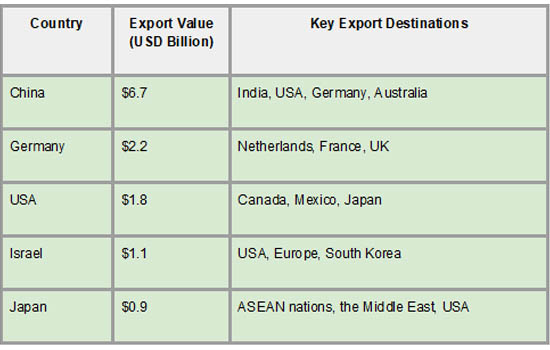
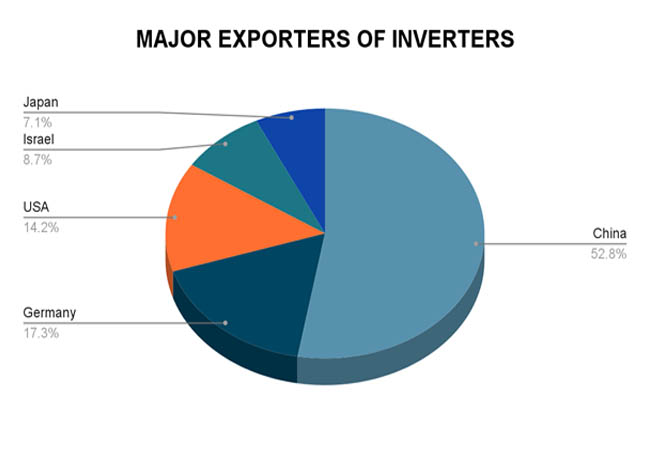
Top Importer Countries of Inverters
As per Import Export Trade Analysis by Import Globals, with over $3.5 billion in imports each year from nations including China, Israel, and Germany, the United States is the biggest importer, mostly to support its growing solar and storage industries. India imports over $2.6 billion worth of inverters, a large portion of which come from China and Germany, amid its aggressive solar energy targets. To satisfy a variety of market demands, Germany imports over $1.9 billion worth of specialized or economical inverters, even though it is a significant exporter. Australia imports over $1.2 billion worth, mostly from the U.S. and China, and has a strong residential solar penetration rate. With $0.9 billion in imports, Brazil is becoming a major importer in Latin America, which is indicative of its growing investments in solar infrastructure.
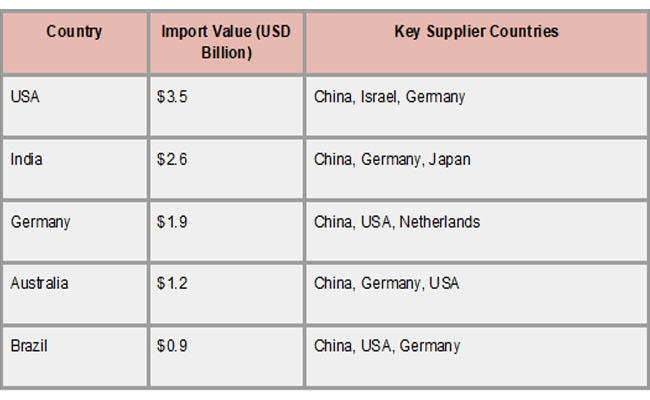
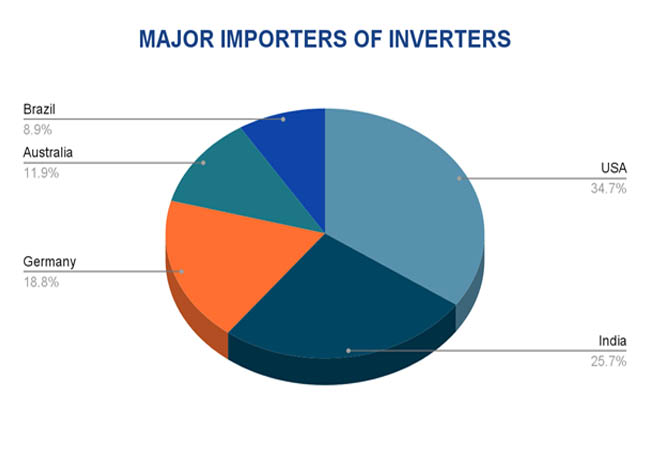
Strategic Implications
The global trade of inverters carries significant strategic implications, especially as nations accelerate their transition toward renewable energy and decentralized power systems. Inverters are not only essential for harnessing solar and battery power but also for enhancing grid stability and energy independence. As per Export Import Global Trade Data by Import Globals, countries heavily reliant on imports, like India and Brazil, are strategically incentivizing local manufacturing through policies and subsidies to reduce dependence on dominant exporters such as China. Meanwhile, innovations in smart inverters and grid integration are reshaping how electricity is distributed and consumed, giving technologically advanced exporters like Germany, the U.S., and Israel a competitive edge. Moreover, as energy security becomes a top priority in geopolitical discourse, control over inverter technology and supply chains is emerging as a key element in national energy strategies and global trade negotiations.
Forecast and Future Trends (2025–2030)
Global inverter shipments are anticipated to reach 150 million units by 2030, with market analysts projecting an average annual growth rate (CAGR) of about 8–10%. Future developments include the increasing use of hybrid inverters with battery storage, the expansion of rooftop microinverter installations for homes and businesses, and the emergence of AI-powered inverters that can optimize the grid and do predictive maintenance. It is anticipated that manufacturing centers would become more geographically diverse as emerging economies like India and Southeast Asian nations increase domestic production to lessen their reliance on imports. As per Export Import Global Trade Data by Import Globals, stricter safety and efficiency regulations, as well as government incentives for clean energy, will further encourage manufacturers to develop more intelligent, long-lasting, and environmentally friendly inverter systems, securing their pivotal position in the global energy transition.
Conclusion
Inverters are indispensable components of the evolving global energy landscape, enabling the seamless integration of renewable sources like solar and battery storage into power grids and everyday applications. The steady growth in inverter demand, driven by technological advancements and the global shift toward clean energy, highlights their strategic importance in achieving energy efficiency and sustainability goals. With manufacturing hubs concentrated in a few key countries and trade flows linking diverse markets, the inverter industry stands at the crossroads of innovation, geopolitics, and economic opportunity. As the market continues to expand through 2030, ongoing investments in quality, smart features, and localized production will be crucial to meeting global energy needs while fostering energy security and resilience worldwide.
If you are looking for detailed and up-to-date Inverters Export Data, You Can Contact Import Globals.
FAQs
Que. What is the role of an inverter in solar systems?
Ans. It converts DC power from solar panels into AC power usable in homes and industries.
Que. Which country is the largest exporter of inverters?
Ans. China leads in inverter exports with over $6.7 billion in value.
Que. Who are the major inverter manufacturers?
Ans. Huawei, SMA, Enphase, SolarEdge, and Luminous are among the top manufacturers.
Que. What drives inverter demand?
Ans. Rising solar installations, industrial automation, and energy storage needs.
Que. Are hybrid inverters better than traditional ones?
Ans. Hybrid inverters offer added flexibility with battery storage but are more expensive.
Que. Where to obtain detailed Inverters Import Data?
Ans. Visit www.importglobals.com or email info@importglobals.com for more information on up-to-date Inverters Import Data.
